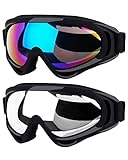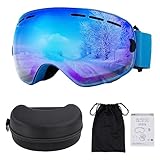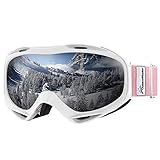Best pair of ski goggles Australia
Which is the best pair of ski goggles in 2024?
VIEW OFFERBest of 2024: Find the right pair of ski goggles in Australia
The best ski goggles protect your eyes and face while offering good visibility and being comfortable to wear, so it’s understandable that many would struggle to find the right product for their needs. This is where our handy buying guide is here to help. It contains a wealth of useful information that will make the buying process that bit easier, with all the important aspects of ski goggles being covered in the guide. This includes what to look for in a pair of high-quality ski goggles and what types of ski goggles are available. With this info, buying the best ski goggles will be easier than ever.
The 10 best ski goggles in Australia (December 2024)
The bestseller list compares ski goggles from multiple brands

- Helmet: Adjustable strap for secure helmet compatibility.
- Glasses: Fits over glasses up to 5.5in length.
- Anti-Fog: Ensures clear vision with REVO double-layer coating.

- Antifog: Double-layer lens design minimizes fogging for clear vision.
- Comfort: Adjustable strap and flexible frame for all face shapes and ages.
- Protection: High-quality PC lenses with wind, dust-proof, and UV 400 protection.

- Convertible: Switch from sunglasses to goggles with ease.
- Impact-Resistant: Durable polycarbonate lenses withstand extreme use.
- Anti-Fog: Clear vision in various weather conditions.

- Vision: Airflow system ensures clear, fog-free vision.
- Protection: Dual lenses and TPU frame ensure maximum eye safety.
- Comfort: OTG design provides ultimate comfort for all users.

- Compatibility: Universal strap adjusts to all helmet types.
- Adaptability: Interchangeable lenses suit varying weather conditions.
- Visibility: Frameless design ensures a clear, unobstructed view of the slope.

- Compatibility: Fits over prescription glasses and helmets with a detachable strap.
- Ventilation: Reduces fogging with professional ventilation and frameless design.
- Versatility: Offers various lenses for different conditions with a detachable system.

- Lens: Multilayer Orion Lens offers superior visibility and technology.
- Comfort: Triple-layer foam provides unparalleled comfort and silk-like feel.
- Durability: Thermo-Plasti frame ensures goggles are nearly indestructible.

- Comfort: Soft TPU frame ensures safety and flexibility.
- Protection: Anti-UV, anti-fog, anti-scratch lens treatment for optimal eye protection.
- Compatibility: Helmet-compatible strap for seamless integration with helmets.

- Clarity: Dual-pane lens with F3 anti-fog coating ensures clear vision and superior fog elimination.
- Compatibility: Streamlined frame design provides full helmet and eyeglass compatibility.
- Proximity: Sits closer to your face than any Oakley goggle before it.

- Compatibility: Fits over glasses and all helmet types.
- Protection: 100% UV400 protection with a soft TPU frame.
- Clarity: Excellent optical clarity with anti-fog lens technology.
Affiliate link: We are a participant of the Amazon Associates Program. If you buy a product through this link we might earn a small commission from Amazon at no extra charge for you. As an Amazon Associate we earn from qualifying purchases.
- Read the definitive pair of ski goggles buying guide
- View the pair of ski goggles picks and see how they rank in the top list
pair of ski goggles buying guide
Do you want to buy a good pair of ski goggles? This is all you need to know.
A short explanation: What are ski goggles?
Ski goggles are protective eyewear worn on ski slopes. A good pair of ski goggles features large lenses and offers high visibility, all the while being helmet-compatible. They provide protection from debris and cold weather, preventing things like frostbite and ‘snow blindness’. Furthermore, ski goggles come with excellent anti-fog properties.
What are the benefits of good ski goggles?
Skiing without a good pair of ski goggles is not a good idea, as it can seriously endanger your eye health. For instance, something called snow blindness is a common condition for skiers that occurs when the eyes are overexposed to UV light. Symptoms of snow blindness include bloodshot eyes, swollen eyelids, temporary loss of vision, and in some extreme cases can even cause permanent damage to your eyes. You are most at risk of developing snow blindness when skiing in high altitudes or climates with heavy overcast. The best ski goggles will prevent any of these conditions occurring while wearing them.
How to choose the best pair of ski goggles in 2024?
Uncertain what makes the best ski goggles for your skiing or snowboarding experience? Here are some important features to consider when buying the right pair for your needs:
- Lens Type: Ski goggles come with various types of lenses, so it helps to know which will best suit your needs. For example, mirrored lenses reduce glare and are ideal for skiing and snowboarding on sunny days, while yellow lenses are suitable for overcast conditions as they enhance contract in low light. Tinted lenses work in most conditions, providing a good balance of light reduction.
- Lens Size: The size of the lens impacts the overall field of vision when wearing ski goggles. Smaller lenses tend to suit recreational skiers and snowboarders, offering a good range of vision without the bulk, while larger lenses provide an unobstructed view in all directions and are thus a popular choice for competitive skiers and snowboarders.
- VLT: Visible Light Transmission (VLT) refers to the amount of light filtered through the lenses, i.e. the lower the amount the darker the lens. Goggles with a lower VLT are designed for use in brighter conditions as they reduce the amount of light that reaches the eyes to prevent distorting your view. The best ski goggles for sunny conditions usually have a rating of 20% to 40%. Goggles with higher VLT let more light through the lenses so are suitable for use in overcast conditions, with the best range usually between 60% and 90%. Many good goggles for skiing have an even higher rating, such as 90-99%, as they are used in very low light without distorting the view. Remember, snow reflects light, so even in overcast conditions, the sunlight is being reflected, which is why you should never use skiing goggles with too low a VLT.
Which types of ski goggles are available to buy in Australia?
The best-selling types of ski goggles include:
- Dual Lens Ski Goggles: This type of ski goggle has a single pane of polycarbonate with a protective coating, reflecting interior, and another lens, providing the tints, all in one. This makes it the most popular type of ski goggle, providing good resistance against the fog and ultraviolet.
- Single Lens Ski Goggles: With a single lens design, these snowboarding goggles are prone to getting foggy as they lack an interior protective lens. A tinted outside lens is featured to protect against ultraviolet, while the interior anti-fog coating helps to prevent fogging.
- Photochromic Ski Goggles: This type of lens adjusts with the light levels, getting darker in bright light and vice versa, so never needs to be changed, offering incredible convenience on the slopes. However, they are rather expensive and difficult to find, especially as a beginner.
